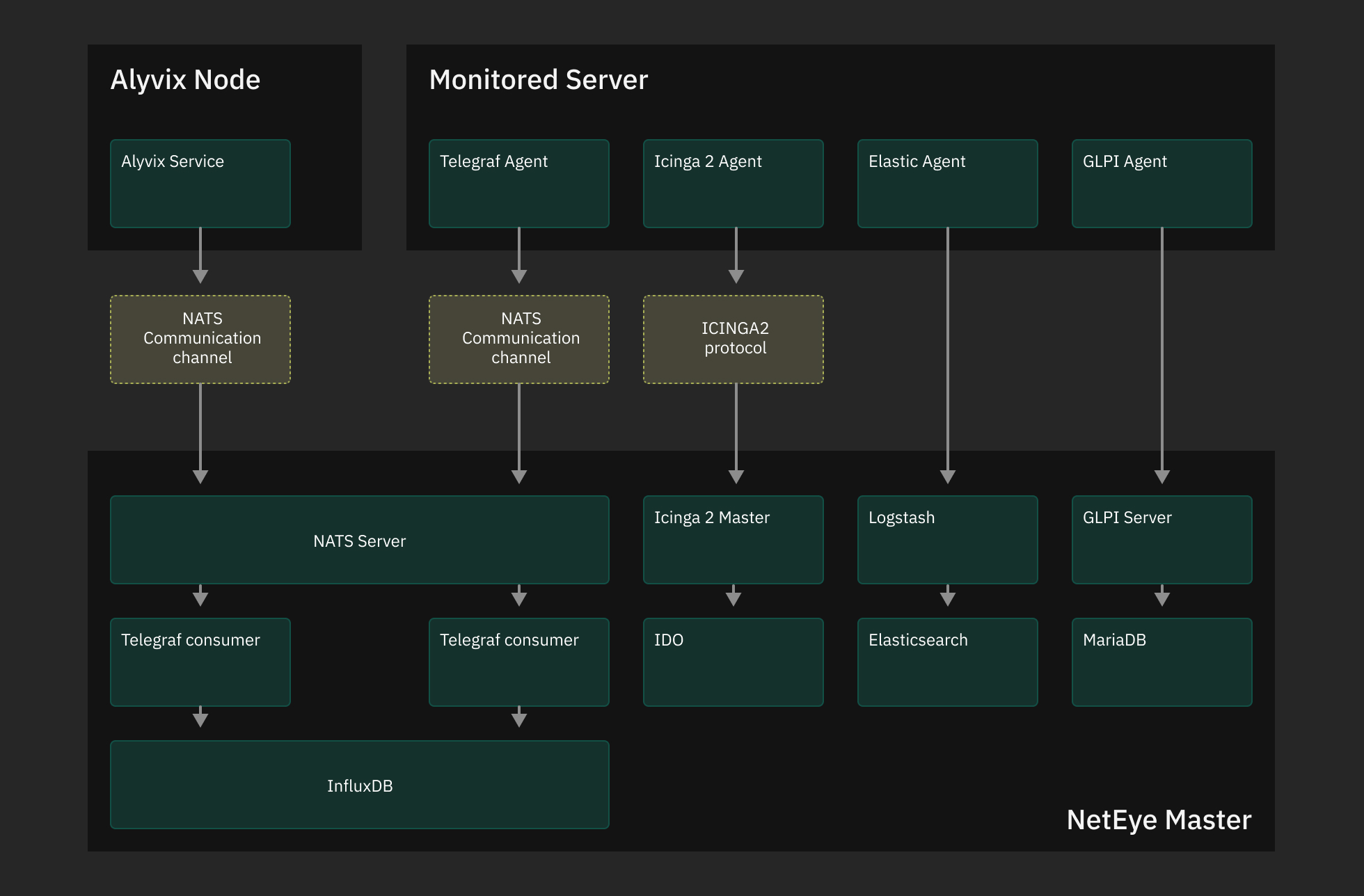NetEye Master¶
Active or passive monitoring processes are concentrated within the main NetEye instance - the NetEye Master. Based on the role distribution within the environment, the Master instance is responsible for:
holding configuration files
sending monitoring configurations to monitored objects previously created in the Director
receiving reports of events from various data sources, and matching those events with the predefined rules
executing actions based on the outcome of the performed analysis
configuring and initiating availability checks on a monitored infrastructure
The NetEye Master functionality for processing received data is granted by Icinga 2 monitoring server, Tornado Engine and Telegraf Consumers. The process of configuring monitoring tasks is controlled via the Director module.
Agents and Data Collecting¶
Retrieving data from the data sources is done by the local agents.
Collecting data for monitoring purposes is performed by means of Agents. Agent is a software that is to be installed on a node to monitor hosts and services. Apart from collecting data, agents are set to perform different tasks, e.g. process data or pass it to the Master, perform health ckecks.
In NetEye hierarchy agents can only have a parent node, i.e. either Master or Satellite. In case Satellites are not involved in the process of data communication, an Agent communicates directly with the Master instance.
While a Satellite can handle a set of hosts, different Agents can be installed on them. In their turn, Agents, can be grouped into tenants.
In order for an agent to operate successfully, make sure that versions of all involved instances are compatible. Namely, agent version should be the same as the version of a Satellite or Master it’s connected to.
Depending on the type of monitoring you would like to perform, i.e. NetEye module you would like to utilize, different agents can be installed on hosts: Icinga agent for Active monitoring purposes, Beats agent (Elastic Stack), Telegraf agent, APM agent, AX Monitor agent, etc.
Icinga Agents
Icinga Agents communicate with the Master within their own Icinga infrastructure. Agents recieve configuration from the Master or a Satellite, and send collected data back to the Icinga instance on the Master. Configurations are generated and distributed to Icinga agents based on the zones.
Telegraf Agents
Local Telegraf Agents are to be configured manually as per which metrics are to be collected. Collected data is then passed to a Telegraf consumer on the Master for further processing. You can learn more on the Telegraf configuration at this page.
Elastic Agents
Elastic Agent is designed to collect and ship data from various sources to Elasticsearch. It is used to replace and consolidate multiple Beats and other agents previously used for data collection. Elastic Agents are pre-configured in the NetEye Master to serve as Fleet Servers: this allows you to easily install and manage Elastic Agents on you monitored hosts via the Fleet UI in Kibana.
GLPI Agents
GLPI Agents are to be installed and configured manually to collect assets and send them to the GLPI Server on the Master. They can be installed on any Windows/Linux machine and configured to send data directly to the Master or trough a NetEye Satellite as a Proxy.
To learn more about how to configure GLPI for Single- or Multitenant environments, please consult GLPI Single Tenancy.
Alyvix Nodes
The Alyvix Node is to be installed and configured manually. NetEye communicates with the Alyvix Service via API calls through the HTTPS communication channels, while NATS serves as a communication channel to send the performance metrics from the Alyvix Nodes to the NetEye Master for service monitoring purposes. Alyvix Test Case execution reports are stored instead on the Alyvix Node.

Fig. 3 Data communication from Agents to the Master.¶
Tornado Collectors
Data gathering for passive monitoring is performed by Tornado Collectors. Collected data flows down the Tornado pipeline, which, apart from the Collectors, contains Tornado Engine and Tornado Executors. The Engine and the Executors are deployed within the Master instance.
A Collector receives information from one or more unstructured sources (e.g. emails or log files), treated as External Events. Based on this a Collector converts External Events into structured Tornado-specific Events, and sends them to the Tornado Engine for further processing. Its main function is to match received events against preconfigured rules, and execute actions in case of a match.
Fig. 4 Outline of the Tornado Pipeline¶
See Passive Monitoring for more information on Tornado.

